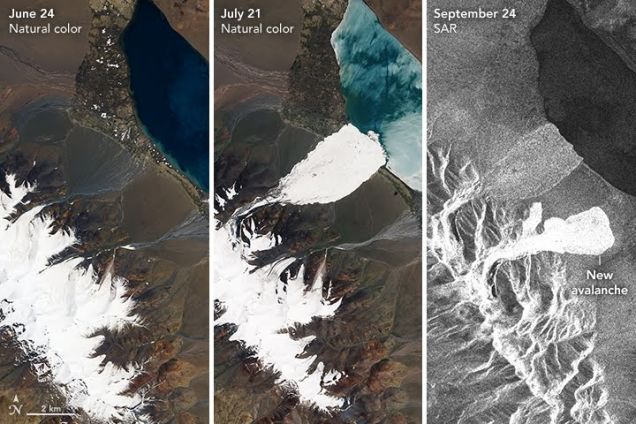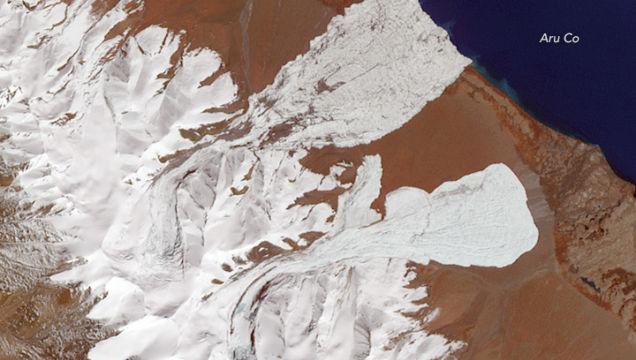Over the summer in Tibet, two enormous avalanches struck the Aru Glacier back-to-back. Now, after several months of careful study, scientists think they have identified the cause of the first ice slide, which claimed the lives of nine nomadic herders. You’ll be shocked to hear it has to do with climate change.
The Aru Glacier of western Tibet, as seen after two enormous ice slides on October 4th. Image: NASA Earth Observatory
When over 70 million tonnes of ice broke off the Aru Glacier in the mountains of western Tibet on July 17, it raised eyebrows in the glaciology community. After all, the collapse was totally unexpected and nearly instantaneous, burying 9.5 square km of valley floor in a matter of minutes. But when another enormous ice slide occurred nearby two months later, jaws dropped to the floor.
“Even one of these gigantic glacier avalanches is very unusual,” glaciologist Andreas Kääb of the University of Oslo told NASA’s Earth Observatory. “Two of them within close geographical and temporal vicinity is, to our best knowledge, unprecedented.”
So, what the hell happened? When Gizmodo reported on the avalanches back in October, the working theory was that a process called “surging”, in which ice flows from the top to the bottom of the glacier and causes it to advance more quickly, primed Aru for a sudden collapse.

Image: NASA Earth Observatory
But a new study, led by researchers at the Chinese Academy of Sciences and Ohio State University, argues that the July 17 ice slide looks less like a case of glacial surging, and more like a case of way too much water seeping to the bottom of the glacier, causing it to detach from bedrock and slide downhill.
“Given the rate at which the event occurred and the area covered, I think it could only happen in the presence of meltwater,” study co-author Lonnie Thompson, who used computer models to recreate the avalanche, said in a statement.
How could so much meltwater have accumulated at the bottom of the Aru Glacier? Nobody’s certain, but Thompson and his colleagues are wagering that an unusually wet spring and long-term warming trends are to blame. Prior to the July avalanche, the nearby meteorological station of Nagri recorded its highest rainfall totals in the last six years. And average temperatures in this part of Tibet have risen rapidly, about 1.5C over the past 50 years — although this past summer was relatively mild.
“It is probable that the recent and rapid warming in this region increased the internal temperature of the ice, which, coupled with increased precipitation, created very unstable conditions,” the authors wrote. “If true, then other glaciers in the region may be experiencing similar conditions, therefore making this region extremely dangerous.”
More work is needed to determine if the second avalanche, which occurred on September 24, had a similar underlying cause. But suffice to say, the possibility that these two events are linked to each other, and to an emerging trend, is terrifying.
[OSU News]
